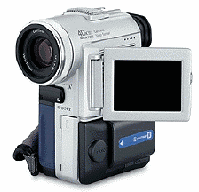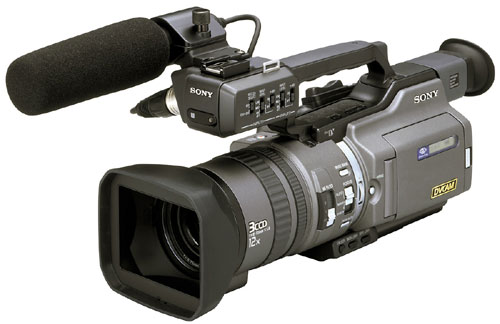
Hitachi's DZ-MV100 This camcorder is unique in that it stores digital images on re-writable DVD-RAM discs housed in the body of the camera. The DZ-MV 100 uses an optical reader that never touches the recording DVD-RAM media, thus reducing wear and tear on the disc. Instead of rewinding or fast-forwarding to access clips, you can locate footage by icons in the view finder, deleting or overwriting sequences at will. This one chip camcorder records as many as two hours of video (60 minutes on each 1.4GB side of the disc) and employs FireWire interfaces for immediate transfer to your PC.
One –chip camcorders
One chip cameras store all of their color information on a single CCD, making them much less expensive than three-chip models. This also makes them extremely small and ideal for the rigors of handheld videos. What these filmmakers save in cost, however, they sacrifice in color data.These one-chip cameras must gather and interpolate all three primary colors for a each pixel on the same diode at the same time.
This is not to say however, that one-chip cameras cant produce works of substantial weight. Director Thomas Vinterberg, for example, won a prestigious Cannes film festival award for his DV production The Celebration, which was shot entirely on a single chip Sony PC7 using built in microphone and auto settings under available light.
Sony DCR-PC100 This $2000 palm size big brother of the pioneering PC1 is a one-chip-mini-mini-DV handycam that switches from 690,000 pixels in video mode to a whopping 1.07 pixels in still photo mode. The PC100 stores photos on removable memory stick storage media.
Three-Chip Camcorders
Because one chip cameras must reconcile all color information on a single CCD, they tend to show color smearing, bleeding, and artifacting in high contrast footage-distressing if you're used to working with a higher quality camera or higher-end format such as Digital Betacam for your shots. Three-chip cameras, in contrast, typically offer better sharpness and color fidelity, and they mix well with footage from most other video formats.

Canon XL-1 This first big star of the digital filmmaking revolution still reigns among DV camcorders, and for some very good reasons: three chip image quality, a light-weight magnesium alloy body, manual control of focus and white balance, and(most of all) a changeable lens mount that accepts more than a dozen video lenses and extenders.
In three-chip camcorders, a beam splitter separates light into three versions of the same image and sends an RGB channel to its own chip - measuring the intensity of one color only. By capturing these disparate color designations, a three-chip camcorder has less interpolation to perform (that is, it doesn't have to make any "guesses" about color), and true color levels become easy to reproduce and playback.

Sony DSR-PD150P This successor to Sony's popular three-chip VX1000, the PAL version of the PD150 camcorder, is treasured among digital filmmakers who hope to one day transfer their video to film stock. The DSR-PD150P provides high quality DV acquisition at 25 frames per second (fps), making the transition into film smoother
Three-chip camcorders run the gamut from low cost consumer models to ultra powerful workhorses designed for TV stations. Many three-chip cameras are exorbitantly priced behemoths that serve digital television (DTV) and Hollywood feature-film production.
2 comments:
Whats a cheap underwatercamera?
Thanks a lot, Sarthak K for sharing such an excellent blog. I found this blog utmost beneficial especially for those who love to have a huge collection of digital video cameras. I will recommend your blog to my friends.
Post a Comment